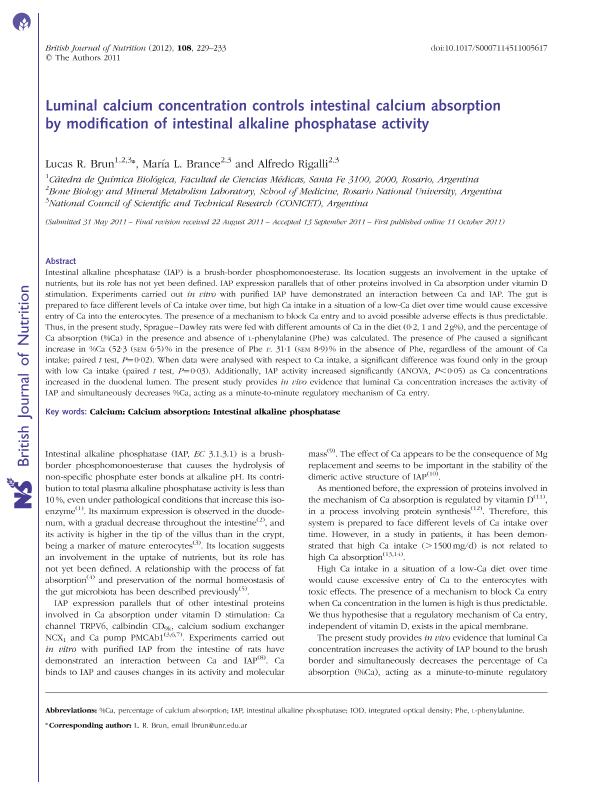Mostrar el registro sencillo del ítem
dc.contributor.author
Brun, Lucas Ricardo Martín

dc.contributor.author
Brance, María Lorena

dc.contributor.author
Rigalli, Alfredo

dc.date.available
2023-05-02T10:59:58Z
dc.date.issued
2012-07
dc.identifier.citation
Brun, Lucas Ricardo Martín; Brance, María Lorena; Rigalli, Alfredo; Luminal calcium concentration controls intestinal calcium absorption by modification of intestinal alkaline phosphatase activity; Cambridge University Press; British Journal of Nutrition; 108; 2; 7-2012; 229-233
dc.identifier.issn
0007-1145
dc.identifier.uri
http://hdl.handle.net/11336/195893
dc.description.abstract
Intestinal alkaline phosphatase (IAP) is a brush-border phosphomonoesterase. Its location suggests an involvement in the uptake of nutrients, but its role has not yet been defined. IAP expression parallels that of other proteins involved in Ca absorption under vitamin D stimulation. Experiments carried out in vitro with purified IAP have demonstrated an interaction between Ca and IAP. The gut is prepared to face different levels of Ca intake over time, but high Ca intake in a situation of a low-Ca diet over time would cause excessive entry of Ca into the enterocytes. The presence of a mechanism to block Ca entry and to avoid possible adverse effects is thus predictable. Thus, in the present study, Sprague-Dawley rats were fed with different amounts of Ca in the diet (0•2, 1 and 2 g%), and the percentage of Ca absorption (%Ca) in the presence and absence of l-phenylalanine (Phe) was calculated. The presence of Phe caused a significant increase in %Ca (52•3 (SEM 6•5)% in the presence of Phe v. 31•1 (SEM 8•9)% in the absence of Phe, regardless of the amount of Ca intake; paired t test, P = 0•02). When data were analysed with respect to Ca intake, a significant difference was found only in the group with low Ca intake (paired t test, P = 0•03). Additionally, IAP activity increased significantly (ANOVA, P < 0•05) as Ca concentrations increased in the duodenal lumen. The present study provides in vivo evidence that luminal Ca concentration increases the activity of IAP and simultaneously decreases %Ca, acting as a minute-to-minute regulatory mechanism of Ca entry.
dc.format
application/pdf
dc.language.iso
eng
dc.publisher
Cambridge University Press

dc.rights
info:eu-repo/semantics/openAccess
dc.rights.uri
https://creativecommons.org/licenses/by-nc-sa/2.5/ar/
dc.subject
CALCIUM
dc.subject
CALCIUM ABSORPTION
dc.subject
INTESTINAL ALKALINE PHOSPHATASE
dc.subject.classification
Fisiología

dc.subject.classification
Medicina Básica

dc.subject.classification
CIENCIAS MÉDICAS Y DE LA SALUD

dc.title
Luminal calcium concentration controls intestinal calcium absorption by modification of intestinal alkaline phosphatase activity
dc.type
info:eu-repo/semantics/article
dc.type
info:ar-repo/semantics/artículo
dc.type
info:eu-repo/semantics/publishedVersion
dc.date.updated
2023-04-28T10:46:20Z
dc.journal.volume
108
dc.journal.number
2
dc.journal.pagination
229-233
dc.journal.pais
Reino Unido

dc.journal.ciudad
Cambridge
dc.description.fil
Fil: Brun, Lucas Ricardo Martín. Universidad Nacional de Rosario. Facultad de Ciencias Médicas; Argentina. Consejo Nacional de Investigaciones Científicas y Técnicas; Argentina
dc.description.fil
Fil: Brance, María Lorena. Universidad Nacional de Rosario; Argentina. Consejo Nacional de Investigaciones Científicas y Técnicas; Argentina
dc.description.fil
Fil: Rigalli, Alfredo. Universidad Nacional de Rosario; Argentina. Consejo Nacional de Investigaciones Científicas y Técnicas; Argentina
dc.journal.title
British Journal of Nutrition

dc.relation.alternativeid
info:eu-repo/semantics/altIdentifier/doi/http://dx.doi.org/10.1017/S0007114511005617
Archivos asociados
